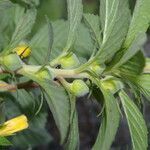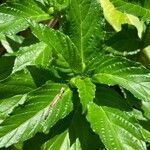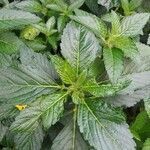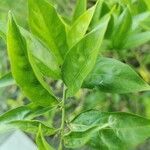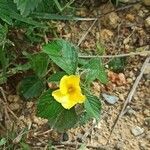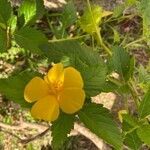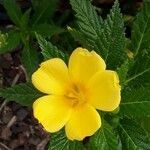Perennial herb, often woody at the base, 40-150 cm high, with a frequently strong taproot; stem terete, usually leafy only in the upper part, densely appressed pubescent. Leaves at the tops of the branches often approximate or even crowded, from a cuneate, entire base rather coarsely dentate-serrate, moderately densely and not very distinctly glandular beneath, on both surfaces moderately densely clothed with longish,±patent or appressed white hairs; midrib strongly prominent beneath; petiole with 2 rather large, apical, lateral glands. Stipules erect, triangular, +-1½ mm, long-hairy. Flowers in the higher leaf-axils. Bracteoles lanceolate, broadest far above the middle, very acute. Calyx densely appressed-pubescent without, not distinctly gland-dotted, glabrous within; tube cylindrical, widened only at the very top, ½-¾ cm long; segments lanceolate, caudately acuminate, up to 2 cm long. Petals with a short, slightly hairy claw; lowermost part of flower not campanulate, blade obovate, 2¼-3 cm by 11-15 mm. Ovary ovoid with 6 small apical tubercles and between them 3 minute style-scars, densely white-hairy with a glabrous green top; styles (stigmas included) ± 2½ cm. Capsule ovoid, obtuse, rather thick-walled, 3-valved to below the middle; valves recurved in the upper part. Seeds cylindric-clavate, at the narrow end ½ crowned by a semiglobose boss, brown, 2¼-2½ cm by 5/6-1¼ mm; aril white.
Herb or shrub 0.2–2 m high, with simple and glandular hairs. Stipules 1 or 2, 0.3–0.7 mm long. Petiole (1.5–) 4–27 mm long, with 2 nectary glands (0.6–1.5 mm diam.) at junction with lamina. Lamina elliptic to ovate, 3.5–15 cm long, 1.3–5.7 cm wide; apex acute; base attenuate or cuneate; margin serrate. Prophyll elliptic to ovate, 6–29 mm long, (1–) 3–12 mm wide. Flowers solitary, homostylous, 19–41 (–60) mm diam. Peduncle 4–19 mm long, fully adnate to petiole or with a free apical portion 0.5–3 mm long. Sepals white or yellow, 14–30 mm long. Petals yellow, 14–30 (–40) mm long. Filaments 11–21 mm long, attached along 5–6 mm of length at base to floral tube forming 5 nectar pockets. Style 8.5–21 mm long. Fruit subglobose, granulose or tuberculate, 3–8 mm long. Seeds 2–3 mm long, blackish.
An small evergreen shrub. It keeps growing from year to year. It grows 1 m tall. The leaves are oval and 10 cm long. They are glossy and dark green. They are softly hairy. The edges have teeth. The flowers are funnel shaped and 5 cm across. The petals are yellow. They have teeth along the edge.
